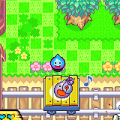- Dragon Quest (Introduction)
- Dragon Quest
- Dragon Quest II
- Dragon Quest III
- Dragon Quest IV: The Chapters of the Chosen
- Dragon Quest V: Hand of the Heavenly Bride
- Dragon Quest VI: Realms of Revelation
- Dragon Quest VII: Fragments of the Forgotten Past
- Dragon Warrior VIII: Journey of the Cursed King
- Dragon Quest XI: Echoes of an Elusive Age
- Slime Mori Mori Dragon Quest
- Dragon Quest Heroes: Rocket Slime
- Slime Mori Mori Dragon Quest 3
- Dragon Quest Heroes
- Dragon Quest Heroes II
The third Slime Mori Mori game moved to the Nintendo 3DS. The Shippodan is up to no good again, though this time they’ve left the citizens of Boingsburg alone and have instead stolen eight magical orbs. It’s up to the heroic slime and his pals to take to the high seas to get them back. The basic formula is more or less the same, but with two major changes.
The first alteration is that the world is much larger – instead of focusing on a single town with various selectable from a map, there’s now a wide world to explore, accomplished by sailing over the ocean. There’s no more slimes to rescue and the town re-building element has gone, as there are now several towns to visit, associated with one of the stages, though they’re quite small. Many of these areas have bosses based on real-life locations from around the Earth – one snowy area is apparently supposed to be Russia since the boss is a giant Matryoshka doll, while a stage based very loosely on the American Wild West has a large, evil Statue of Liberty.
The developers must’ve realized how popular the tank battles were in the previous game, and so there’s a much greater emphasis placed on them here, which is the second biggest change. Rather than waging war with tanks, here you’re commanding your very own pirate ship. While the tank battles in Rocket Slime were more like miniboss/boss battles, here you’ll regularly encounter opponents when sailing out at sea. You’ll spend even more crafting ammunition and customizing your ship’s structure, both in finding items during the regular stages, and through running fetch quests for various townsfolk.
It makes sense that the developers would want to expand on this part of the game, but it comes with its own issues. Most of the stronger items have been re-balanced so the battles are much more challenging, but conversely, they’re now so frequent that you can easily get tired of them. There’s no way to escape from an enemy once you encounter them, and even frivolous encounters take a few minutes. The game has as many areas as its predecessors but the play time will probably end up being at least twice as long since you need to spend so much time both in ship combat and grinding for ways to improve it. The exploration sections feel even more shallow than they did before since there’s no longer any extra slimes to search for. Plus, the slimes you do encounter in your adventure no longer have individual names either, which is a little sad.
The graphics have received an overhaul. The backgrounds and large elements like bosses are now rendered with polygons, as are the sailing and ship combat segments, while most of the characters re-use the sprites from the previous games. It doesn’t look bad for an early 3DS title, though it can’t help but feel like a slight step down, plus it means a less smooth framerate. Much of the music has also been re-used from the previous games, and by this point it’s also worn out its welcome.
If you just couldn’t get enough of the tank combat from Rocket Slime, this is a worthwhile effort, but it can’t help but feel like the developers took an interesting concept and then kinda ran it into the ground.
Unfortunately, the game was not localized, as Square-Enix was a little inconsistent about the Dragon Quest games it was translating at this point, likely due to the underperformance of the spin-off titles as well as the DS ports of the later mainline games. Again, this is a shame – though it still requires navigating through some menus to tune up your ship, it’s a relatively easy to game to play with minimal Japanese knowledge. But it does get by thanks to its always ridiculous sense of humor, which is almost totally lost without the ability to read it.

